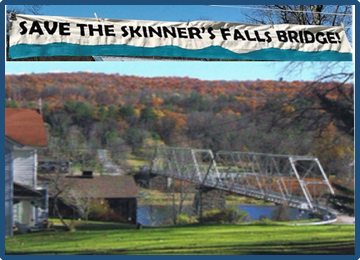
Join the DCS Sustainable Sing-Along, Sunday, Dec. 8 in Narrowsburg, NY
November 21, 2024
Advocacy Day, Jan. 28, to Reduce Plastic Waste in NYS
December 3, 2024November 22, 2024 letter from DCS attorney Lauren Williams to the Advisory Council on Historic Preservation:
Good afternoon,
On behalf of Damascus Citizens for Sustainability, I am forwarding the email below and associated attachments to the Advisory Council on Historic Preservation regarding an ongoing and extremely time-sensitive situation involving PennDOT and the National Register-listed Skinner’s Falls/Milanville Bridge. PennDOT presently seeks to dismantle the entire Bridge, minus one abutment, on the basis of a bridge inspection that the public has not even seen, and due to conditions that PennDOT created.
The ACHP has expressed serious concern in the past regarding the failure of PennDOT to protect, preserve, and rehabilitate historic bridges in the state. ACHP previously condemned, in the context of the Pond Eddy bridge fight, what appears to be a pattern of PennDOT allowing historic bridges to decrepitate while it pushes through new 40-ton bridges in areas where such massive bridges are not needed, and where the community overwhelmingly wants rehabilitation of the historic bridge.
The same processes that ACHP previously criticized appear to be happening again with the Skinners Falls Bridge (Milanville, PA/Cochecton, NY), which is located in the Upper Delaware Wild and Scenic River Corridor. The Bridge is on the National Register, and is the anchor of the National-Register-listed Milanville Historic District. The Bridge also is:
an extremely rare example of a multi-span pin-connected Baltimore truss bridge . . . among the oldest known bridges associated with the American Bridge Company, having been built shortly after the company’s formation. The bridge is also ornately decorated, including portal knee bracing decoration, portal cresting, decorative builder plaque. There are also original lattice railings that are 20 inches in height and which feature beautiful decorative flower motifs. This is to say nothing of the geometric beauty of the complex Baltimore truss configuration combined with the complexity of the riveted built-up beams that contain v-lacing and lattice. (Bach Steel 2021 Comment Letter (attached in comment package)).
The Bridge, due to lack of proper expert maintenance, has been deteriorating and has been closed to traffic since 2019. PennDOT has been pushing to replace the Bridge with a 40-ton, two-lane bridge. This is despite community support for bridge rehabilitation, including support from bridge preservationists including Bach Steel, which has offered its services.
PennDOT’s pattern of allowing historic bridges to deteriorate, and, in turn, to advance unpopular and destructive projects has come to a head regarding the Skinners Falls Bridge. PennDOT now wants to dismantle the majority of the Bridge, claiming an “emergency” situation that is largely one of its own making. Earlier this year, PennDOT received reports of debris falling from the Bridge into the River below. PennDOT now claims, based on an “in-depth bridge inspection” that it has not publicly disclosed, that it needs to dismantle the following: the Bridge, the NY abutment (which it claims may collapse), and the middle pier of the Bridge (due to navigational concerns, not structural issue). PennDOT wants to store the Bridge parts in trailers in a PennDOT parking lot/stockyard for an indeterminate amount of time under unknown conditions that may damage the Bridge parts further.
The email below identifies multiple problems with the emergency project process that PennDOT sprung on the public earlier this month and that involves the FHWA. Such problems include an improper claim that this is somehow a categorical exclusion under NEPA. We have also attached letters that DCS has previously written to PennDOT regarding its lacking public process on the overall bridge project, and PennDOT’s attempts to predetermine an outcome for bridge replacement.
We kindly ask that ACHP get involved as a bulwark to prevent PennDOT (and FHWA) from abusing the Section 106 and NEPA processes to provide cover for bridge destruction. We are very concerned that PennDOT is using this “emergency”, which it helped create, as a step to get rid of the bridge and justify replacement. We also request that ACHP pressure PennDOT to provide the public with information outright, instead of the public having to ask for every document, which allows PennDOT to hide important material from the public. Lastly, we want to understand better what tools ACHP can use to push PennDOT to ensure that we do not lose this unique, valuable, and extremely rare National Register-listed Baltimore truss bridge.
Thank you for your time. If you have questions or need additional information, please feel free to contact us. We look forward to hearing from you.
Lauren Williams
Counsel for Damascus Citizens for Sustainability
November 21, 2024 email from DCS attorney Lauren Williams to PennDOT and AECOM:
Attachments to the email below:
Project search results on the emergency bid package
Dec. 18, 2021 from DCS to PennDOT and AECOM
Aug. 24, 2021 from DCS to PennDOT Chief Counsel
June 1, 2021 from DCS to PennDOT and AECOM
Good evening,
I am counsel for Damascus Citizens for Sustainability, a consulting party regarding the Skinners Falls Bridge projects. We are deeply concerned about the process and lack of available public information regarding the proposed emergency dismantling of the historic Skinners Falls Bridge (MPMS #122260). There remains a lack of trust among many in the community, particularly given what happened with the Pond Eddy Bridge, and PennDOT’s treatment of historic bridges in other areas of the state, such as District 6 and historic bridges in Tinicum Township.
I.
First, during the virtual presentation/Q&A on November 14, it was stated that there is, or may be, a consulting party meeting on November 25, the Monday of Thanksgiving week. It is now less than 2 business days before the 25th, and there is no information on whether this meeting is happening, and if it is, where/how and when it is to occur. This is unacceptable. If the meeting is indeed on the 25th, it needs to be rescheduled for a clearly-announced date and time so that people can plan their schedules to attend.
Please confirm the meeting time and date, and that it will be held at a time when people can attend. The last meeting was at 2pm during a workday.
II.
Second, it is not clear what is going to be different at this meeting from the one on November 14. The public still has no access to the following documents and information, as mere examples:
- Draft agreement document and disassembly/storage plan, which was originally promised to be available before the November 14 meeting (per Nov. 8, 2024 Section 106 public notice);
- Qualifications to be required of the company doing the dis-assembly, manner by which parts will be labeled, stored, and protected from moisture;
- Recent bridge inspection documents, including documents from the “in-depth bridge inspection” that PennDOT is relying on for its emergency action, and information provided to PennDOT from the Upper Delaware Council;
- Bid package documents and contractor requirements, which appear to be posted on ECMS (see attached), but during the Nov. 14 meeting, were said not to exist yet (as you know, ECMS bid documents are not accessible to the public);
- Information about other alternatives already implemented by PennDOT to protect river traffic (e.g. bridge netting).
This list is not exclusive, but merely illustrative. There cannot be meaningful public comment under Section 106 when important documents (e.g. the document disassembly and storage plan) are not yet available for public review. Likewise, there is no meaningful public participation without the public having access to other important materials on the proposed historic bridge dismantling including contractor requirements and bid packages. The lack of access is particularly alarming when the estimated bid let date in the STIP is currently December 2, 2024. The public, including knowledgeable historic bridge preservationists, deserve to understand how storage of the bridge components in trailers is going to be monitored to ensure that the components will not deteriorate due to lack of consistent conditions while stored in trailers in a parking lot for an unknown length of time. Funding in the 12 year transportation plan suggests no substantial work on the bridge is going to happen until after 2030. That is a significant amount of time for the community to have lost its historic and scenic bridge. Having the Bridge removed for that long also alters environmental conditions on the River.
DCS recognizes that a catastrophic collapse of the bridge is dangerous and undesirable. However, PennDOT has allowed the bridge to deteriorate over a significant length of time, thus creating an emergency that could have been avoided, particularly if rehabilitation and preservation were prioritized at PennDOT, as such work is at other state transportation agencies such as VDOT.
Please confirm that all documents listed above, as well as other materials pertaining to the emergency action, will be provided to consulting parties via PATH. Consulting parties should not have to Right-to-Know request the documents from PennDOT when it is on the agency to ensure a proper Section 106 and NEPA process.
III.
Third, during the November 14 meeting, PennDOT’s consultant claimed that either the emergency project or the entire Skinners Falls Bridge project is a “Level 2 CE”. At the same time, the consultant claimed that the NEPA process still had to be initiated. This is contradictory, and does not make sense legally or factually.
Factually, PennDOT has been proceeding with this project as if there is a NEPA process. It developed a purpose and need statement already. This is not consistent with a categorical exclusion. It also undertook a PEL study, and although that study was improperly narrowed to transportation considerations, again, the PEL study would be superfluous if a categorical exclusion applied. For PennDOT to turn around and say the bridge project is categorically excluded would mean that PennDOT wasted important time and taxpayer money that could have gone to rehabilitating the bridge sooner. While the processes PennDOT undertook were flawed (see attached DCS letters previously sent), they clearly indicate that PennDOT anticipated, rightly, a full NEPA process.
Legally, the project does not qualify as a categorical exclusion under FHWA regulations (23 C.F.R. s 771.117(b), (c)(28), (e)). While we recognize that PennDOT and FHWA appear to have a programmatic agreement that places projects that fall under Section 771.117(e) as “Level 2 categorical exclusions”, this is inconsistent with FHWA’s own regulations. Further, the programmatic agreement specifically requires FHWA approval of any categorical exclusion classification for projects that, inter alia, involves certain impacts to historic resources, and that affects “federally listed Wild and Scenic Rivers.” (Section IV.A.1.ii.). The Skinners Falls Bridge is such a project.
Please advise and clarify as to how PennDOT, FHWA, and its consultants are treating the emergency project (MPMS #122260) and the overall project (MPMS #9983) under NEPA.
IV.
In closing, please clarify the questions and issues identified above under Points I, II, and III.
Lastly, we want to make you aware that the newly-updated PennDOT site has altered the Skinners Falls Bridge project page, and there is now no information about the proposed emergency action, and the links to the questions posted on November 14th, and the November 14th meeting video, are gone.
Thank you for your time, and we look forward to hearing from you promptly.
Lauren Williams
Counsel for Damascus Citizens for Sustainability



